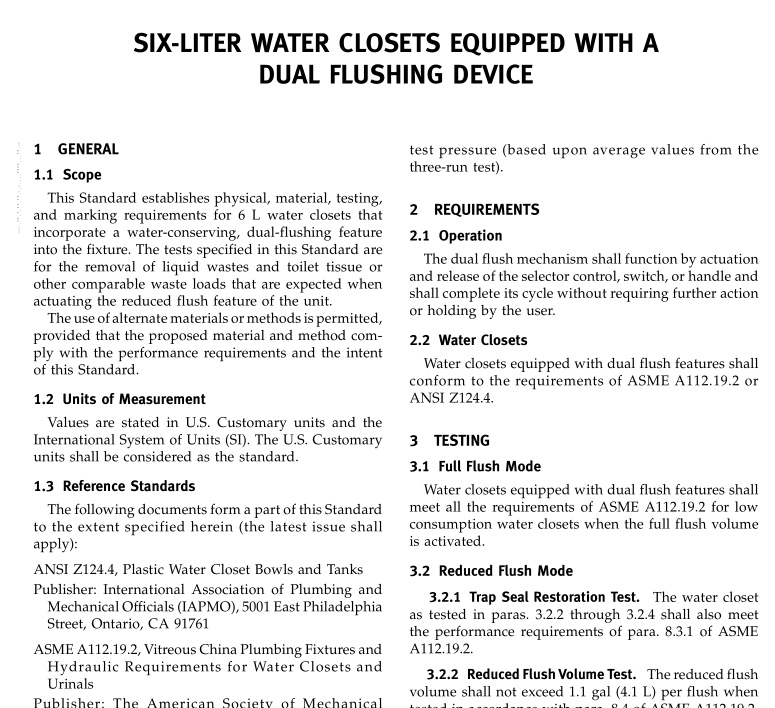ASME A112.19.14 pdf download

ASME A112.19.14 pdf download Six-Liter Water Closets Equipped With a Dual Flushing Device
(c) 0.34 oz (10 mL) of this solution shall be removed from the bowl and shall be added to 5.75 oz (170 mL) of clean water in a suitable container (i.e., dilution ratio of 17:1). A sample of this solution shall be set aside in a test tube or comparator vial as the control sample. (d) The water closet shall then be flushed several times to ensure that all traces of the dye solution have been removed. One ounce (30 mL) of the dye solution [see para. 3.2.3.1(a)] shall be added to the bowl. The flushing device shall be actuated and released in a normal manner and the test fixture shall be allowed to complete its filling cycle. A test tube or comparator vial shall be filled with water from the water closet bowl and compared against the control sample. The test shall be repeated two additional times and the results shall be averaged. NOTE: Use of a spectrophotometer shall be permitted in case of doubt; however, this method shall necessitate the use of a different color dye.
3.2.3.2 Performance Requirement. A dilution ratio of at least 17:1 shall be obtained in each initial flush, for the average of the three tests.
3.2.4 Toilet Paper Test
3.2.4.1 Test Media. The paper removal test in the reduced flush cycle shall be conducted as follows:
(a) the test load shall be composed of four balls of six sheets of untreated single-ply toilet paper
(b) each crumpled into a loose ball measuring 2 in. to 3 in. (51 mm to 76 mm) in diameter. The standard size test sheet shall be 4.5 in. 4.5 in. (114 mm 114 mm). The single-ply toilet paper shall first meet both the absorption and wet tensile strength requirements given in paras. 3.2.4.1.1 and 3.2.4.1.2, respectively.
3.2.4.1.1 Absorption
(a) Test Method. A six-sheet strip of the proposed toilet paper shall be obtained. The paper shall be wrapped snugly around a piece of 2 in. Schedule 40 PVC pipe. The paper shall be slid off the pipe. The tube of paper shall be grasped approximately halfway down its length and shall be turned inside out and down over itself. This shall result in a ball approximately 2 in. (51 mm) in diameter. The ball (straight edges down) shall be dropped into a pan of water. The time it takes for the ball to become fully saturated and sink below the water surface shall be recorded.
(b) Performance Requirement. The paper ball shall sink below the surface in less than 3 sec.
3.2.4.1.2 Wet Tensile Strength
(a) Test Method. A 2 in. Schedule 40 PVC coupling and union nut shall be used as a frame to hold the toilet 2 paper for the wet tensile strength test. Place one sheet of the toilet paper on the coupling and the union nut shall be slid over the coupling. The frame shall be inverted and the paper shall be submerged in water for 5 sec. The frame shall then be removed from the water and shall be returned to an upright position. A 0.312 in. (8 mm) diameter steel ball weighing 2 g ± 0.1 g shall be placed in the center of the wet sheet.
(b) Performance Requirement. The sheet shall support the steel ball without any evidence of tearing.
3.2.4.2 Test Method. The four 2 in. to 3 in. (51 mm to 76 mm) balls ofpaper thatcomply with paras. 3.2.4.1.1 and 3.2.4.1.2 shall be dropped into the water directly above the well and shall be allowed to wet out com- pletely. Within 5 sec after wetting occurs, the bowl shall be flushed. This procedure shall be repeated until three sets of data are obtained. Note whether any paper is left in the bowl. Flush again and collect any paper that discharges from the outlet.
3.2.4.3 Performance Requirement. No paper shall remain in the well after each initial flush.
3.2.5 Durability Test 3.2.5.1 Test Method. The water closet shall be cycled 15,000 cycles in the full flush mode and, after each of the four full flushes, one reduced flush shall be made followed by 60,000 cycles in the reduced volume flush mode.
3.2.5.2 Performance Requirement. At the comple- tion of the test, the dual flush switch, actuator, or levers shall show no sign of deterioration that would affect performance. They shall function smoothly and shall activate with a force of 5 lbf (22 N) or less.
4 MARKING
4.1 Identification of Flush Mode Options Identification of flush mode options shall be depicted on the actuator. This identification shall be either by graphic display or lettering, or shall be intuitively apparent.









